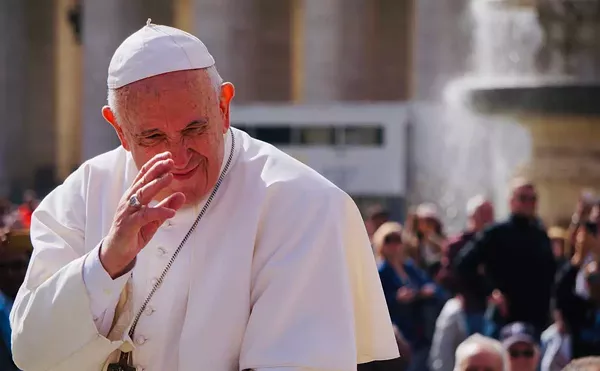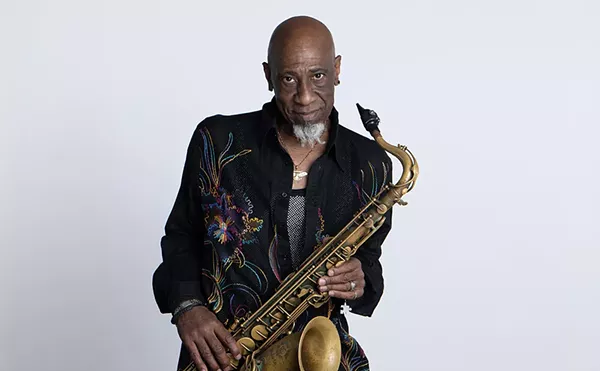
Audio By Carbonatix
[
{
"name": "GPT - Leaderboard - Inline - Content",
"component": "35519556",
"insertPoint": "5th",
"startingPoint": "3",
"requiredCountToDisplay": "3",
"maxInsertions": 100,
"adList": [
{
"adPreset": "LeaderboardInline"
}
]
}
]
I am looking at an old picture postcard; it is both extraordinary and also entirely commonplace. That's the mystery: how it can be both. I have collected a few of these cards -- 15 or 20 -- over the years. They're part of a game I play, a mystery game. Some of the cards are blank; others have writing, including this one, postmarked Oct. 24, 1915. The date is interesting, but the inscription -- like most -- is irrelevant, a message exchanged between people long dead. Strangers to me. The game isn't about the writing, but about the Detroit scenes imprinted photographically on the old cards.
In 1915, when my card was mailed, Americans were still moving into cities, instead of out. (It wouldn't be until the 1920 census that the United States became a predominantly urban society.) Henry Ford's $5 a day was news, and Detroit was on its way to becoming the motor capital of the world, with a population that tripled between 1900 and 1920, reaching a figure just under a million -- same as today, following the demographic U-turn of a city that once had twice as many residents. "City of tomorrow." "Where life is worth living." That's what people once said about this place.
Cities used to tell people something about themselves, something they wanted to believe; cities made people feel heroic, larger than life, noble. Urbanity, that's what it was about: the idea that city things, even city air, if you can believe that, were better simply because they originated here. Now -- provided they "work" -- cities are more like shopping malls, or at least that's how we interpret them. Heroism has nothing to do with it; you go there (residents and visitors alike) to spend money and be entertained.
They're selfish places and lonely, where the majority of Americans no longer live, but visit only periodically, expecting to be served. City postcards now all seem ironic, a joke. "Having a great time in Indianapolis." Right. The colors are wrong, the surfaces too shiny. The cards are ugly, like the interchangeable convention centers where they are sold.
And that, in reverse, is the source of the game I play with the old postcards, which are beautiful in a way that only believed-in things ever get to be. I lay them out on a table, trying to fix the city scene in my mind -- that city of 60 or 80 years ago, whose residents are now dead. What would it have felt like to live in their Detroit, the Detroit of the old photographs? It's a mystery. "The Photograph does not call up the past," the French writer Roland Barthes suggests, in a beautiful little book, Camera Lucida. "The effect it produces ... is not to restore what has been abolished (by time, by distance) but to attest that what I see has indeed existed." And that is the wonder of the old cards: They attest to a city lost to me, but still living there. It existed, once: city of the dead, city of tomorrow, city of heroic possibility.
There's one place in Detroit where that city endures, if paradoxically: a city of distinguished architecture, with beautiful houses and monuments, and historic neighborhoods where no restoration is required because they never decayed; a city with a population that has kept growing over the years, through good times and bad, wars and depression, riots and suburban flight; a city with safe, well-maintained streets, where rich and poor, black and white have settled down together; a city where nature and urban necessity have made the most of each other's company.
That's the city pictured in my newest old postcard -- a mysterious city, a literal city of the dead. The card carries a photograph of Elmwood Cemetery. Elmwood was established in 1846 by a group of private investors; out in the country then (when Detroit's population was just over 21,000), on acreage purchased from George Hunt's farm. The project was modeled on Mt. Auburn Cemetery in Boston, created 15 years before, an early example of the so-called "garden" cemetery.
These were distinct from old city graveyards or church burial grounds -- like Mt. Elliott Cemetery, established in 1841 by the Catholic Church, on land adjacent to Elmwood. (In 1850 Temple Beth El bought half an acre in the southeast corner of Elmwood and established what became the oldest Jewish cemetery in Michigan.) The aims of Elmwood's creators were more urbane, with the measure of their success becoming obvious in my postcard. The parklike grounds are being strolled by idling visitors beneath the great trees; a fountain plays in the middle distance. Marble monuments are visible on a handsome incline that borders either side of the well-appointed roadway. It's a "city beautiful."
I walk that same route today -- alone -- the postcard idlers long gone; I pass by great mansion-house mausoleums set into the hillside of Chief Pontiac Valley (named for the Ottawa leader who ambushed British troops near here, troops who were hoping to do the same to him, on the morning of July 30, 1763). I've come to visit my first friend in Detroit, Terry King, dead before he had any business being so, who called for a plot from the sickbed he never managed to get back out of. He wanted a spot next to Hiram Walker -- that Hiram Walker -- and here Terry is, on a beautiful hilltop, overlooking the monuments of governors and senators and captains of industry, the Civil War dead, black leaders, firefighters and lots of common folks buried here.
"Perpetual care," a little plaque reads, embedded in the hillside, and everywhere -- visibly -- that contract applies. The faces of angels and figures bowed in grief, the inscriptions on the stones themselves, are softened by the care each passing season spends here, perpetually. Styles once new -- neoclassical, Gothic, Romanesque, Queen Anne, the ostentatious obelisks so numerous once -- are overtaken by history, but the contract still holds. The kind of demolition commonplace everywhere else would be vandalism here, in this city built of time. And that's the care-full mystery.
Terry's hilltop overlooks a place unique in Detroit, where past and present abide, where loss revisited invites something better, more deeply humane; not the selfish privacy of cities nowadays, but a sympathy that enlarges just because it is shared. Like the "tragic optimism" of the blues (as Stanley Crouch says), or like the belonging of my old postcards. "More than ever," the Dutch architect Rem Koolhaas writes, "the city is all we have." City of the dead: a mystery it will require all our courage to embrace.
E-mail comments to letters@metrotimes.com




